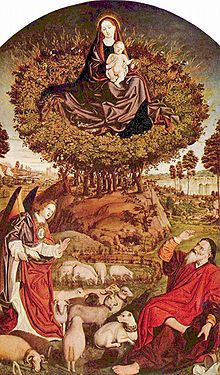Burning bush

In the Burning Bush ( Hebrew הַסְּנֶה בֹּעֵר ha-səneh boʕēr , Ex 3.2 EU ), according to the story in the Tanach ( Ex 3.1 EU to Ex 4.17 EU ), God appeared on Mount Horeb to Moses to give him the order to bring the people of Israel out of Egypt to lead . When Moses asked, he also gave him his name YHWH there .
Meaning of the name of God
The name of God, often according to Ex 3.14 EU ( אֶהְיֶה אֲשֶר אֶהְיֶה ehyeh ăšer ehyeh ) translated as "I am who I will be", according to the Septuagint "I am the one" ( ἐγώ εἰμι ὁ ὤν egô eimi ho ôn ), was used with great reverence by the Israelites. They replace the tetragram (four-letter word, YHWH) with expressions such as “ the name ”, “the Eternal” or “ Adonai .” Jesus of Nazareth used the thorn bush scene in the Sadducee question as scriptural evidence for the resurrection . Here God is understood as the “living” or “as the God of the living”.
The theologian Erich Zenger distinguishes four aspects of the self-conception of God in the thorn bush scene:
- Reliability: “I am there with you so that you can count on me. If you also walk in the valley of death, you can count on me to be there. Even if you run away from me doubtful, screaming or become mute, you should know: I am there with you, even if you no longer recognize me. "
- Unavailability: “I am there with you in such a way that you have to reckon with me when and how I want - maybe even then and in such a way as it even bothers you. There may well be situations and stations on your life path where you do not like to be reminded that I want to be with you or where you would rather have another God. "
- Exclusivity: “I am there with you in such a way that you only count on me as the one who can be close to you to save you. To count on me requires you to make a clear decision to take it seriously that I am the only one for you who can give you support and measure. Only in me can and may you encounter true love, true goodness and true life. "
- Infinity: “I am there with you in such a way that my being close knows no local, institutional and temporal limits. If I am with you, it does not exclude that I can even be with your enemies. Yes, my saving closeness transcends the earth on which you live and which you so often make the center of your life. Even death is not a limit for me that could limit my life force. "
Others
A bush of the blackberry variety Rubus sanctus is venerated today in St. Catherine's Monastery on Sinai as an offshoot of the burning bush.
The diptame ( Dictamnus albus ) from the diamond family is also known as the “burning bush”. The plant secretes aromatic oils that can ignite on hot days. As a model for the burning bush in the Bible, however, the diptame is hardly an option because it has no thorns.
The motif of the burning bush was picked up in literature and music. Examples are the drama The Burning Bush by Oskar Kokoschka (1911) and the opera fragment Moses and Aron by Arnold Schönberg .
Literature and Sources
- Joseph Ratzinger : Introduction to Christianity. Lectures on the Apostles' Creed. With a new introductory essay . 6th edition of the completely unchanged new edition 2000. Kösel, Munich 2005, ISBN 3-466-20455-0 , p. 132.
- Erich Garhammer , Udo Zelinka (Ed.): Burning thorn bush and Pentecostal tongues of fire. Biblical traces in modern literature (= insights . 7). Bonifatius-Verlag, Paderborn 2003, ISBN 3-89710-227-7 , pp. 161-176.
- Romano Guardini : Mémorial des Pascal. In: Romano Guardini: Christian Consciousness. Trials on Pascal . 2nd Edition. Kösel, Munich 1950, p. 47 f.
- Klaus Kiesow, Thomas Meurer : On the history of the impact of the thorn bush scene (Ex 2.23-4.18) . In: Klaus Kiesow, Thomas Meurer (ed.): “Textarbeit”. Studies on texts and their reception from the Old Testament and the environment of Israel. Festschrift Peter Weimar on the completion of his 60th year of life with contributions from friends, students and colleagues (= Old Orient and Old Testament . 294). Ugarit-Verlag, Münster 2003, ISBN 3-934628-23-0 , pp. 585-610.
- Heinrich A. Mertens: Handbook of Biblical Studies. Literary, historical, archaeological, religious, historical, cultural, geographical aspects of the Old and New Testaments. A workbook for teaching and preaching. 2nd revised edition. Patmos, Düsseldorf 1984, ISBN 3-491-78326-7 .
- Leonhard Ragaz : The Bible. An interpretation . Published under the patronage of Ernst Ludwig Ehrlich . New edition of the seven-volume original edition (Zurich 1947–1950) in 4 volumes. Edition Exodus, Zurich a. a. 1990, ISBN 3-905575-52-3 .
- Herbert Vorgrimler : Marginalia on Pascal's piety in the church . In: Jean Daniélou , Herbert Vorgrimler (ed.): Sentire Ecclesiam. The awareness of the church as a formative force of piety. ( Hugo Rahner on his 60th birthday) . Herder, Freiburg im Breisgau a. a. 1961.
- Erich Zenger : The God of the Bible. A non-fiction book on the beginnings of the Old Testament belief in God. Katholisches Bibelwerk, Stuttgart 1979, 3rd edition 1986, ISBN 3-460-31811-2 .
Web links
- Felipe Blanco Wißmann: Dornbusch. In: Michaela Bauks, Klaus Koenen, Stefan Alkier (Eds.): The Scientific Bibellexicon on the Internet (WiBiLex), Stuttgart 2006 ff., Accessed on January 27, 2013.
Individual evidence
- ↑ Erich Zenger: The God of the Bible. A non-fiction book on the beginnings of the Old Testament belief in God. Stuttgart 1979, 3rd edition 1986.
